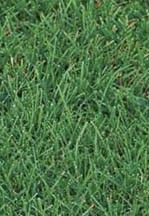 If you live in an area with long hot summers where the temperatures are consistently over 85o F and the winters are mild you may be interested in using warm-season grasses in your lawn. They grow most vigorously in the warm months and turn brown in winter. They can be mixed with each other or with cool-season grasses depending on the conditions, to produce an attractive lawn.
If you live in an area with long hot summers where the temperatures are consistently over 85o F and the winters are mild you may be interested in using warm-season grasses in your lawn. They grow most vigorously in the warm months and turn brown in winter. They can be mixed with each other or with cool-season grasses depending on the conditions, to produce an attractive lawn.
There are six warm-season grasses commonly available for lawns. Comments and evaluations are relative to other warm-season grasses mentioned in the article.
Bahia Grass (Paspalum notatum): Coarse texture, medium green
-
Strengths: Good for control of soil erosion; shade tolerant, moderately drought tolerant; tolerant of sandy, infertile soils; excellent wearability; not prone to produce thatch; stays greener longer than other warm-season grasses; some disease tolerance; low maintenance
Weaknesses: Coarse texture; requires frequent mowing; susceptible to brown patch, army worms, and mole crickets; poor cold tolerance.
Bermuda Grasses
 Common Bermuda Grass (Cynodon dactylon): Medium to fine texture, medium green; often used on golf courses.
Common Bermuda Grass (Cynodon dactylon): Medium to fine texture, medium green; often used on golf courses.
-
Strengths: Medium to fine texture; heat and drought tolerant; excellent wearability; grows well in poor soils, sandy to clay; high salt tolerance.
Weaknesses: Spreads quickly and can become invasive and weedy; poor shade tolerance; susceptible to brown patch, dollar spot, leaf spot, pythium blight, armyworms, sodworms and others in humid areas; turns brown when temperatures are consistently below 60o F.
 Hybrid/Improved Burmuda Grass: Produces no seeds.
Hybrid/Improved Burmuda Grass: Produces no seeds.
-
Strengths: Finer texture, denser, and greener than common Bermuda grass; more pest and disease resistance than common Bermuda grass; heat and drought tolerant; excellent+ wearability; high salt tolerance.
Weaknesses: Poor shade tolerance; turns brown when temperatures are consistently below 60o F; prone to thatch build up; invasive but less so than common Bermuda grass; needs high nitrogen levels; very high maintenance
St. Augustine Grass (Stenotaphrum secundatum):Coarse to medium texture, dark green.
-
Strengths: Fast growing spreading by stolons; shade tolerant; high tolerance to salts
Weaknesses: Poor drought tolerance; poor wearability; tendency to produce thatch; susceptible to disease and pest problems with some varieties more resistant than others; high maintenance.
Centipede Grass (Eremochloa ophiuroides) Medium to fine texture, light green.
-
Strengths: Moderate shade tolerance in some soils; low fertilizer needs; tolerant of acid soil; some disease resistance; low maintenance
Weaknesses: Poor drought tolerance; low wearability and slow to recover; goes brown quickly in hot dry weather and in cool weather; poor disease resistance.
Zoysia Grass (Zoysia spp): Fine to medium texture, dark green.
-
Strengths: Tolerant of a wide variety of soils; shade tolerant; drought tolerant
Weaknesses: Wiry leaves; goes brown quickly in winter and slow to green up in spring.
Warm-season grasses are generally vigorous and spreading so can become invasive and are prone to thatch. They are heat tolerant and demand less water than cool-season grasses but go brown when cool temperatures arrive. Use of a warm-season grasses with an overseeding of cool-season grasses can produce a very attractive green lawn all year in mild climates.
